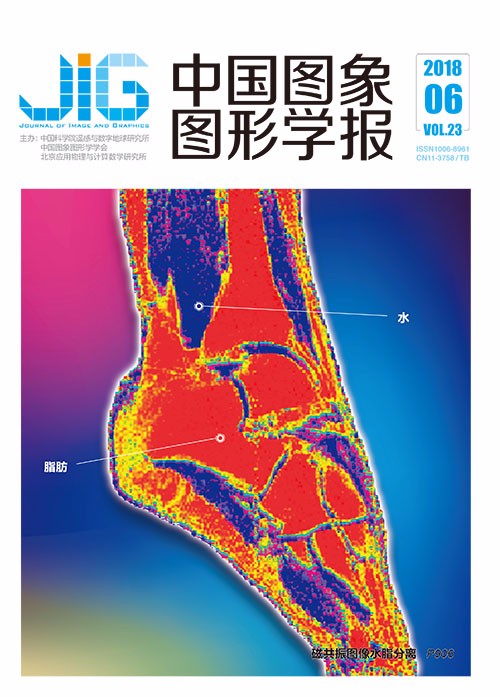
复合域的显著性目标检测方法
摘 要
目的 针对显著性目标检测方法生成显著图时存在背景杂乱、检测区域不准确的问题,提出基于复合域的显著性目标检测方法。方法 首先,在空间域用多尺度视网膜增强算法对原图像进行初步处理;然后,在初步处理过的图像上建立无向图并提取节点特征,重构超复数傅里叶变换到频域上得到平滑振幅谱、相位谱和欧拉谱,通过多尺度高斯核的平滑,得到背景抑制图;同时,利用小波变换在小波域上的具有多层级特性对图像提取多特征,并计算出多特征的显著性图;最后,利用提出的自适应阈值选择法将背景抑制图与多特征的显著性图进行融合,选择得到最终的显著图。结果 对标准测试数据集MSRA10K和THUR15K中的图像进行显著性目标检测实验,同目前较流行的6种显著性目标检测方法对比,结果表明上述问题通过本文方法得到了很好地解决,即使在背景复杂的情况下,本文算法的准确率、召回率均高于对比算法,在MSRA10K数据集中,平均绝对误差(MAE)值为0.106,在THUR15K数据集中,平均绝对误差(MAE)值降低至0.068,平均结构性指标S-measure值为0.844 9。结论 基于复合域的显著性目标检测方法,融合多个域的优势,在抑制杂乱的背景的同时提高了准确率,适用于自然景物、生物、建筑以及交通工具等显著性目标图像的检测。
关键词
Saliency object detection method based on complex domains
Cui Liqun, Zhao Yue, Hu Zhiyi, Zhao Yukang(School of Software, Liaoning Technical University, Huludao 125105, China) Abstract
Objective Saliency object detection with development of human visual attention mechanism has been widely studied by computer vision researchers. Visual significance is an important mechanism of human visual system. It simulates the human visual attention mechanism, extracts the most interesting areas of the scene quickly and accurately, and ignores redundant information. Saliency object detection has been widely used in image compression, segmentation, redirection, video coding, target detection, recognition, and many other tasks. Although numerous significant target detection methods are available, problems remain. For example, the detection results look well when the background is simple, but when the background is complex, the results may have some uncertainty as regards the environment, cluttered background in the area around the target, or influence of selection on the significant target detection method. The problem of cluttered background and inaccurate detection area often occurs when the salient object detection method generates significant graphs. To solve these problems, saliency object detection method is proposed based on complex domain. The complex domain combines frequency, spatial, and wavelet domains; takes advantage of the complex domain to combine the advantages on three domains; and suppresses the background to obtain an accurate and clear salient target area. Method Environmental conditions are one of the key factors that influence saliency object detection; for example, weak light or foggy days can cause unclear images and lead to poor results of significant target detection. Multi-scale retinex is an image enhancement algorithm based on color theory. By introducing multi-scale retinex algorithm, the image restoration is realized by linear weighting in the process of dynamically scaling a picture. First, multi-scale retinex enhancement algorithm is used to preliminarily process the original image in spatial domain and exclude environmental impacts. After image processing, the brightness becomes more appropriate to the real scene brightness, and the foreground and background contrast is also significantly improved. In addition to the environmental impact, the background areas of the non-significant target often occupy most of the image space in the saliency object detection images. These background areas increase the error detection problem and reduce the accuracy rate. Experiments found that most background areas are the sky, trees, grasslands, and buildings, which are beyond the scope of this study. The characteristics of the background areas with repeatability can be suppressed by hyper-complex Fourier transform. Then, undirected graph is established and node features on the images are extracted preliminarily. The hyper-complex Fourier transform in the frequency domain is reconstructed to acquire the smoothing amplitude spectrum, phase spectrum, and Euler spectrum. Then, background suppression graphs are obtained through the smoothness of multi-scale Gaussian kernel. At the same time, the multi-level feature of wavelet transform in the wavelet domain is utilized to extract multiple features in terms of images, and the saliency graph of multiple features is calculated. The saliency graph effectively preserves the details of the image because of the unique localization characteristics of the wavelet domain. Finally, the proposed adaptive threshold selection method is used to fuse the background suppression diagram with the saliency graph of multiple features and the final saliency graph is selected and obtained. The final saliency figure suppresses the background while preserving the details of the image. Result To make the experimental effect persuasive, saliency object detection experiments in the standard test dataset images MSRA10K and THUR15k are conducted. MSRA10K datasets consist of 10 000 images of hand-annotated and accurate to pixel-level salient target annotations, including images of natural scenery, biology, architecture, and transportation. THUR15K datasets consist of 15 000 web images with five keywords, namely, butterflies, airplanes, giraffes, cups, and dogs, representing significant targets with pixel precision as the former datasets. The two datasets are public standard image databases and are widely used in salient target detection and image segmentation. A total of 300 background-complex pictures are selected from each dataset, under the same experimental conditions, and compared with six popular significant target detection methods. Results show that the problems presented by our method had a good solution. Even in a complex environment, the accuracy and recall rate of the algorithm are higher than those of state-of-the-art contrast algorithms. In MSRA10k datasets, the mean absolute error (MAE) value is 0.106; in THUR15K datasets, the mean absolute error value was reduced to 0.068, and the average structure (s) measure value was 0.844 9. The result of the MAE evaluation reflects the advantage of a saliency object detection method based on complex domain in terms of overall performance, and the s-measure indicates that the detected target is highly similar to the structure of the target of the ground truth graph. Conclusion Saliency object detection is a promising preprocessing operation in image processing and analysis. In this study, a new saliency object detection method based on complex domain is proposed. Multi-scale retinex algorithm in spatial domain can be used for pretreatment of images; it enhances contrast and prevents images from being affected by environmental factors. Hyper-complex Fourier transform in the frequency domain can suppress complex repetitive background regions, and the significant target detection method in the wavelet domain can completely describe the details of the target. Moreover, the proposed algorithm integrates the advantages of multiple domains and improves the accuracy while suppressing background clutter. Thus, the proposed algorithm is suitable for detecting significant target images, such as natural scenery, biology, architecture, and transportation. To improve the algorithm speed, our next research project aims to reduce the complexity of the algorithm by using the influence of wavelet transform function on time complexity.
Keywords
salient objects detection multi-scale Retinex enhancement algorithm hyper complex Fourier transformation wavelet transform adaptive threshold selection method
|



 中国图象图形学报 │ 京ICP备05080539号-4 │ 本系统由
中国图象图形学报 │ 京ICP备05080539号-4 │ 本系统由